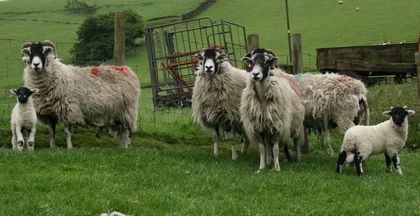Vaccination knocks footrot for six

A Lancashire flock’s long-running problem with footrot – creating weeks of extra work, reducing ewe productivity and increasing the culling rate – has been virtually eliminated since a vaccination policy was introduced.
Richard Hargreaves, who runs 1250 Swaledale ewes at Meadow Bank, Barley, Burnley, with his brother John, says the annual vaccination cost of about 70p a ewe is “some of the most worthwhile money we spend all year”.
Before trying out footrot vaccination – initially on part of the flock – the Hargreaves brothers had spent 10 years battling with seriously lame ewes. They reckon the time spent dealing with foot problems amounted to almost six weeks a year.
The wet land on this 250ha (620-acre) farm – most land is severely disadvantaged fell – did no favours to sheep’s feet and over the years the footrot problem intensified.
“We used to trim all ewes’ feet twice a year – before tupping and after lambing – but we were constantly treating individual ewes with problems all year round. After trimming the feet they’d start to heal, but then you’d end up having to take off all the other hoof gain,” says Mr Hargreaves.
“Many ewes had hooves that were so loose there was no alternative but to remove the entire hoof and then there’d be the inevitable infection to deal with. We were foot-bathing sheep all summer, but no matter what we did we couldn’t get on top of it.”
Lambs were picking it up too and the Hargreaves brothers were in no doubt the flock’s foot problems were also taking their toll on ewe performance.
“A ewe with sore feet doesn’t come to the tup when she should and then she ends up lambing down in really poor condition and probably only has a single instead of twins. Or we’d see lame ewes with two weak lambs because she wasn’t thriving and so wasn’t making enough milk to feed them. Footrot was costing us a lot of money.”
The brothers decided to try vaccinating 700 of the Swaledale ewes from the farm’s crossing flock, which is put to Bluefaced Leicester tups.

They were vaccinated in September/October with a subcutaneous injection in the upper part of the neck. The jab did leave a small scab, but there was no other side-effect.
A few weeks following the injection there was a noticeable improvement, with far fewer sheep showing any signs of lameness and within a year there were virtually no lame sheep at all among vaccinated ewes.
“The hoof grew back much harder and didn’t pick up any infection. The feet seemed to be wearing much better with the harder horn – something we’d never managed to achieve with any treatment we’d carried out before we started vaccinating.”
The following year the fell sheep, suckling pure-bred Swaledale lambs, were run with the vaccinated ewes suckling Mules. The vaccinated sheep remained free of footrot while the fell sheep showed the usual high degree of lameness.
The decision was then taken to vaccinate the entire flock, including all the Swaledale gimmer lambs retained as replacements.
When ewes were brought in for lambing this spring there was only a handful showing any sign of lameness – something Mr Hargreaves says has made a big saving on labour as well in the productivity of the flock.
“Vaccination is costing us about £1000 a year, but it’s worth every penny. It’s hard to think we used to spend at least three weeks trimming sheeps’ feet prior to tupping time – apart from all the other time spent – and even then we weren’t getting on top of the problem.”
Routine foot-bathing is no longer needed and the brothers agree ewes are not only lasting longer, but are rearing lambs better.
“As soon as you start trimming a sheep’s feet to the level we were having to do you know it’s the beginning of the end and more serious foot problems will finally lead to the ewe being culled.”
As well as vaccinating all ewes, all Swaledale and Bluefaced Leicester tups brought on to the farm are vaccinated to ensure they don’t bring any infection with them.
